
- 592 pages
- English
- ePUB (mobile friendly)
- Available on iOS & Android
eBook - ePub
About this book
This concise and practical guide thoroughly presents the characteristics of children with specific mild exceptionalities in today?s diverse classroom. Using an active, problem-solving approach that reflects how today?s students learn, Dr. Sydney S. Zentall identifies the characteristics of children with mild exceptionalities that can be gleaned from observations, written descriptions, and personal interactions. Unlike many texts on this topic, which overwhelm students with extraneous information, The text focuses on the characteristics of these students within general education and special class settings. With this knowledge readers will better understand the implications of characteristics for accommodations and be ready to apply this knowledge with empirically based interventions.
Frequently asked questions
Yes, you can cancel anytime from the Subscription tab in your account settings on the Perlego website. Your subscription will stay active until the end of your current billing period. Learn how to cancel your subscription.
No, books cannot be downloaded as external files, such as PDFs, for use outside of Perlego. However, you can download books within the Perlego app for offline reading on mobile or tablet. Learn more here.
Perlego offers two plans: Essential and Complete
- Essential is ideal for learners and professionals who enjoy exploring a wide range of subjects. Access the Essential Library with 800,000+ trusted titles and best-sellers across business, personal growth, and the humanities. Includes unlimited reading time and Standard Read Aloud voice.
- Complete: Perfect for advanced learners and researchers needing full, unrestricted access. Unlock 1.4M+ books across hundreds of subjects, including academic and specialized titles. The Complete Plan also includes advanced features like Premium Read Aloud and Research Assistant.
We are an online textbook subscription service, where you can get access to an entire online library for less than the price of a single book per month. With over 1 million books across 1000+ topics, we’ve got you covered! Learn more here.
Look out for the read-aloud symbol on your next book to see if you can listen to it. The read-aloud tool reads text aloud for you, highlighting the text as it is being read. You can pause it, speed it up and slow it down. Learn more here.
Yes! You can use the Perlego app on both iOS or Android devices to read anytime, anywhere — even offline. Perfect for commutes or when you’re on the go.
Please note we cannot support devices running on iOS 13 and Android 7 or earlier. Learn more about using the app.
Please note we cannot support devices running on iOS 13 and Android 7 or earlier. Learn more about using the app.
Yes, you can access Students With Mild Exceptionalities by Sydney S. Zentall in PDF and/or ePUB format, as well as other popular books in Education & Inclusive Education. We have over one million books available in our catalogue for you to explore.
Information
Appendix II
Appendix II Data for Case Study 11.1: Lily (“She shouted, ‘NO!’”) (adapted from an assignment submitted by Jia Liu)
Background. The S Preschool has two classrooms. One is for 3-year-old children and the other is for 4-year-olds. Usually there are around 10 children in the morning in the 3-year-old class; 7 of the children come from China, and the others come from countries such as Egypt and Puerto Rico. In the classroom there are four little tables with several chairs where children sit to do art projects, to play with blocks or puzzles, and to have snacks. The classroom also has a rug area where they play with toys, listen to instructions, and read books. Other items in the classroom are a cage in which a big white rabbit is kept and a little house that imitates a home with furniture. Mary is the young female American teacher of this class. Two adult assistants are also in the class every day. Among the Chinese children, Lily is the only girl. She is the only child of her family.
Setting 1: Free Play Time

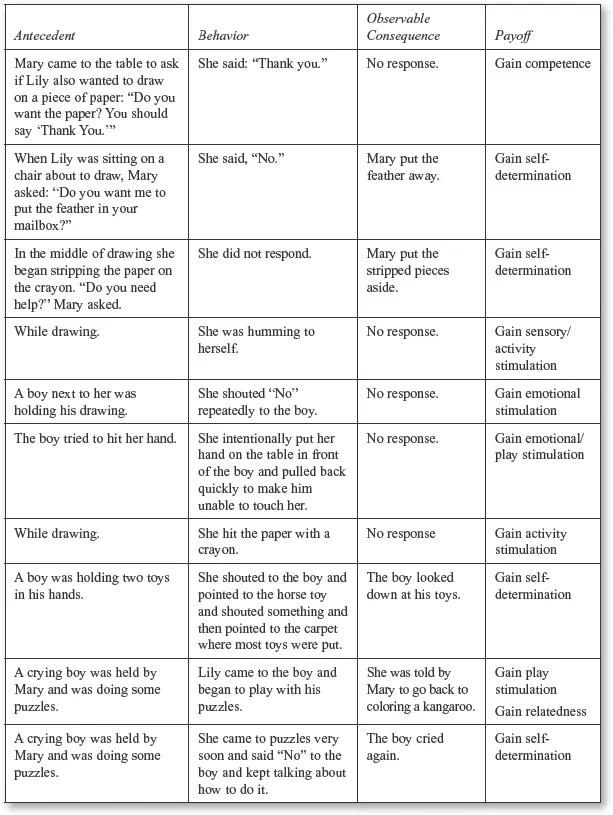
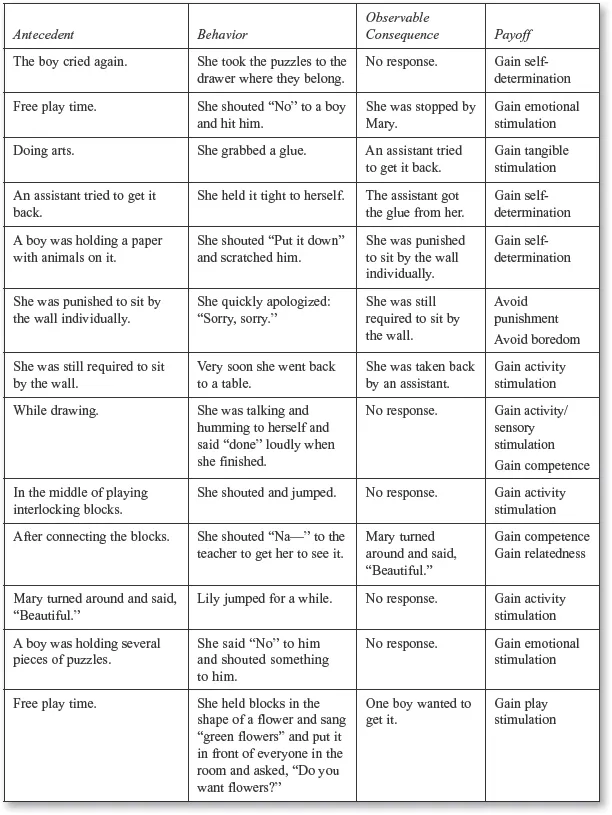

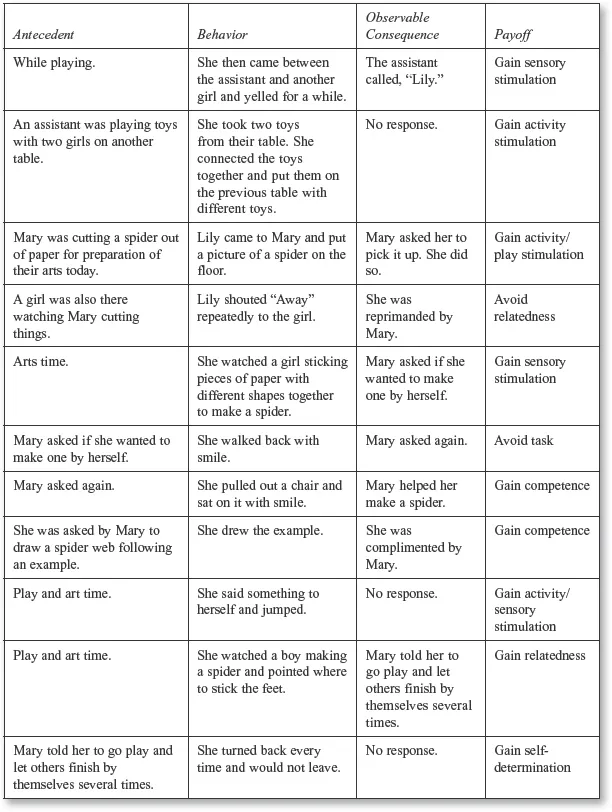
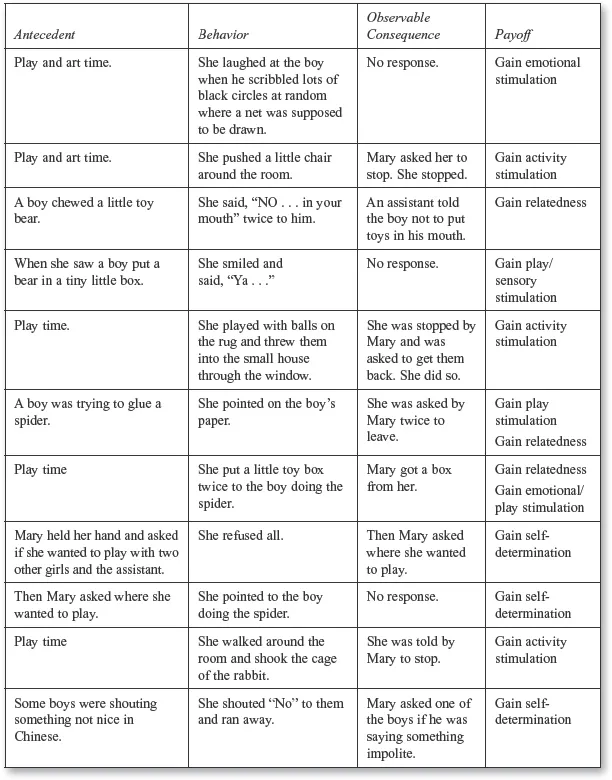
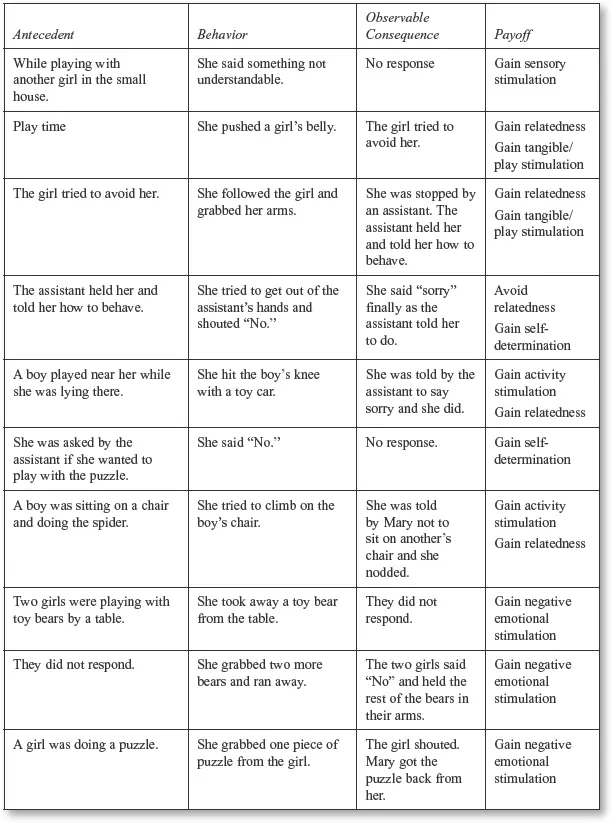
Setting 2: Group Instruction
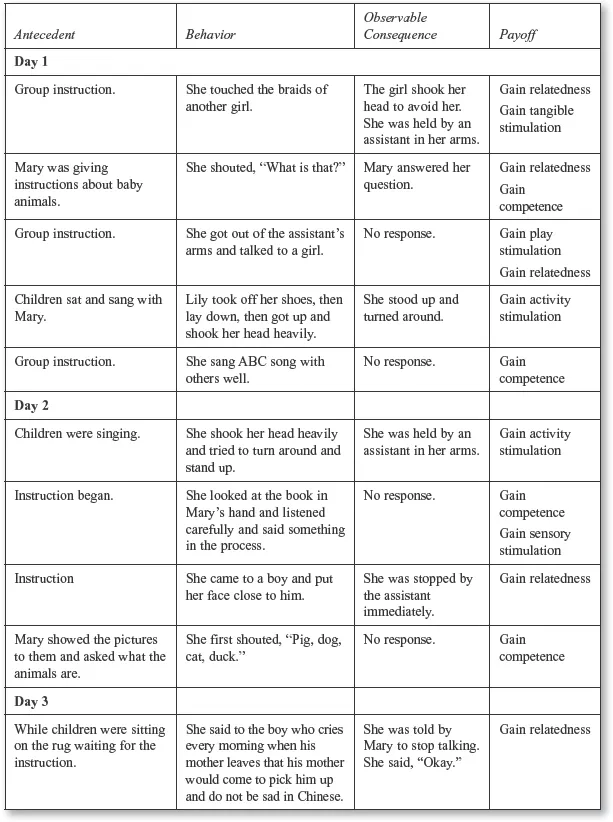

Setting 3: Snack


Setting 4: Reading Plus Other Activities



Setting 5: Playground


Glossary
AAC: Augmentative and alternative communication. AAC devices provide technological support for the language that the child has: verbal (speech) or nonverbal/gestural modes of communication (pointing or mechanical output systems) and alternative communication methods that bypass the oral system of communication. (Section II)
Abreactions: The release of emotions by acting out; often a reaction against a set of circumstances. (Section III)
Abstract thinking: The ability to go beyond visually based concrete events or objects to form visual concepts, such as greater than, and symbols, such as understanding that one thing can represent many. For example, a picture of a chair can represent a chair and a color (e.g., red and green) can represent an action (stop/go). Verbal abstract processing involves making categories, such that a word or group of words can represent an idea (e.g., fairness). (Section III)
Abstract verbal language: The degree to which language involves more than the concrete naming of things and moves to descriptions of objects (adjectives), descriptions of actions (adverbs), and use of abstract prepositions, along this continuum: (a) single words—nouns (objects, concepts, categories), verbs (simple verbs, verb tense), adjectives, prepositions; (b) phrases and sentences (following directions); (c) paragraphs and stories; (d) cause and effect, (e) drawing of inferences; (f) fact versus opinion; (g) absurdities and humor; (h) idioms and figures of speech (“on the rocks,” “over the hill”). (Section II)
Accommodations: Changes in the setting or task that are made by the teacher to bring out optimal responding...
Table of contents
- Cover
- Dedication
- Title Page
- Copyright
- Brief Contents
- Detailed Contents
- Preface
- Section I. Introduction to Mild Exceptionalities
- Section II. Verbal and Nonverbal Learning Disabilities
- Section III. Cognitive Exceptionalities
- Section IV. Attentional Disorders
- Section V. Social Disorders
- Section VI. Motor Disorders
- Appendix I. Council for Exceptional Children (CEC) Standards for Core Competencies Represented in This Text
- Appendix II. Data for Case Study 11.1: Lily
- Glossary
- References
- Index
- About the Author